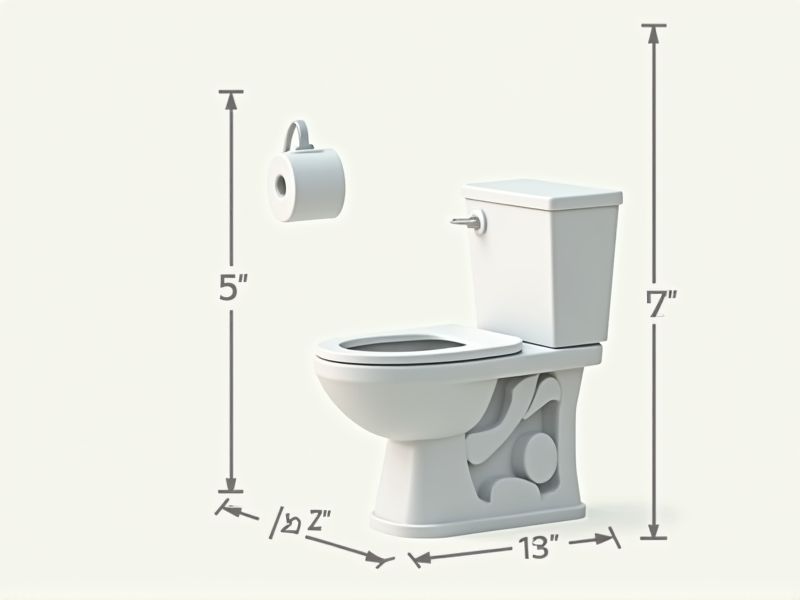
When choosing a standard toilet for your home or project, it's helpful to know the typical dimensions to ensure a comfortable fit. Most standard toilets have a height from the floor to the top of the seat of about 15 to 17 inches, while "comfort height" models can be up to 19 inches. The typical depth (from the front of the bowl to the back of the tank) ranges between 27 and 30 inches, and the width is usually around 20 inches. Always measure your available space and check manufacturer specifications, as actual dimensions can vary based on style and design.
Standard Bathroom Stall Size.
A standard bathroom stall typically measures 36 inches wide and 60 inches deep, providing adequate space for comfortable usage. The height of the partition is often around 58 to 62 inches, ensuring privacy while allowing for ventilation. In compliance with accessibility guidelines, stalls designed for individuals with disabilities usually measure at least 60 inches wide, ensuring enough room for maneuverability. When planning your bathroom layout, consider these measurements to enhance functionality and user experience.
Toilet Seat Height.
The standard toilet seat height typically ranges from 16 to 18 inches from the floor, catering to an average adult's comfort and convenience. For individuals with mobility challenges or the elderly, elevated toilet seats, around 18 to 22 inches, provide enhanced accessibility. The Americans with Disabilities Act (ADA) recommends a height of 17 to 19 inches for accessible toilets, ensuring compliance for public facilities. When selecting a toilet, consider your household's needs, as the right seat height can significantly impact daily convenience and accessibility.
Distance From Wall To Toilet.
The standard distance from the wall to a toilet should be around 15 to 18 inches, providing enough space for comfort and accessibility. This measurement ensures adequate legroom while seated, promoting proper hygiene and ease of use. For a more accessible design, compliance with ADA standards suggests a minimum distance of 16 inches from the center of the toilet to any side wall. Ensuring this distance can also facilitate easier cleaning and maintenance around your bathroom fixtures.
Standard Ada Compliant Dimensions.
To ensure accessibility, toilet designs must adhere to the standards set by the Americans with Disabilities Act (ADA), which specifies a minimum width of 60 inches for wheelchair maneuverability. The toilet height should range between 17 to 19 inches from the floor, making it accessible for individuals with mobility impairments. Grab bars must be installed within a specific reach range of 33 to 36 inches above the floor to provide adequate support. These dimensions are integral for creating an inclusive environment, allowing everyone to use restroom facilities comfortably and safely.
Minimum Toilet Room Size.
The minimum toilet room size is typically recommended to be at least 30 square feet, allowing for adequate space to maneuver comfortably. This size usually accommodates essential fixtures such as a toilet, sink, and, when applicable, a small storage unit. Dimensions often stipulate that the width should ideally be no less than 5 feet, ensuring users can access the toilet without obstruction. Meeting these standards not only enhances comfort but also adheres to building regulations for safety and accessibility.
Toilet Paper Holder Placement.
The standard height for a toilet paper holder is typically between 26 to 30 inches from the floor, ensuring easy access while seated. Placing the holder within 12 inches of the toilet rim enhances convenience, allowing users to reach for the paper without strain. When installing, consider a distance of about 8 to 12 inches in front of the toilet for optimal functionality. Proper placement not only improves user experience but also contributes to the overall aesthetics of your bathroom space.
Space Between Toilet And Vanity.
The ideal space between a toilet and vanity should be at least 15 inches to provide comfortable access and usage. Ensuring this distance can enhance overall bathroom functionality and hygiene, as it allows room for cleaning and maintenance. When designing a small bathroom, optimizing this layout can prevent congestion and ensure ease of movement, benefiting your daily routine. A well-planned bathroom design not only improves aesthetics but also boosts property value, with increased interest in functional layouts.
Standard Toilet Width And Depth.
The standard toilet width typically measures around 14 to 16 inches, while the depth usually ranges from 28 to 30 inches. These dimensions ensure a comfortable fit in most bathrooms, accommodating various user needs. Your choice of toilet should also consider the height, which usually stands between 15 to 17 inches for standard models. Ensuring proper measurements can enhance usability and create a pleasant bathroom experience.
Minimum Clearance Around Toilet.
The minimum clearance around a toilet should be at least 15 inches from the center of the toilet to any side wall or adjacent fixture. This space is crucial for providing comfortable access and ensuring proper hygiene. In front of the toilet, a minimum clearance of 24 inches is recommended to allow for ease of movement. Ensuring these clearances can significantly enhance your bathroom's functionality and accessibility.
Height Of The Flush Tank From The Floor.
The standard height of a flush tank is typically set between 15 to 20 inches from the floor, ensuring optimal user comfort and accessibility. A flush tank positioned too high can lead to difficulty in operation, particularly for children and individuals with mobility challenges. Manufacturers often design tanks to align with ergonomic standards, making it essential for homeowners and builders to consider this measurement when installing new toilets. Installing your flush tank at the recommended height can significantly enhance user experience and bathroom functionality.
